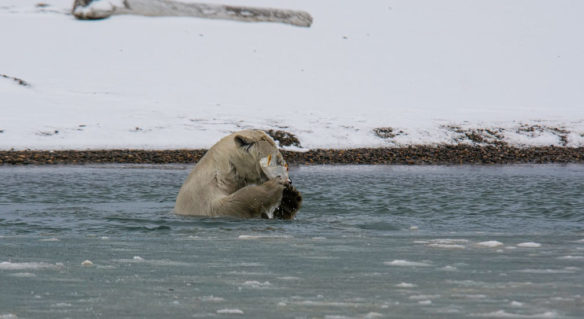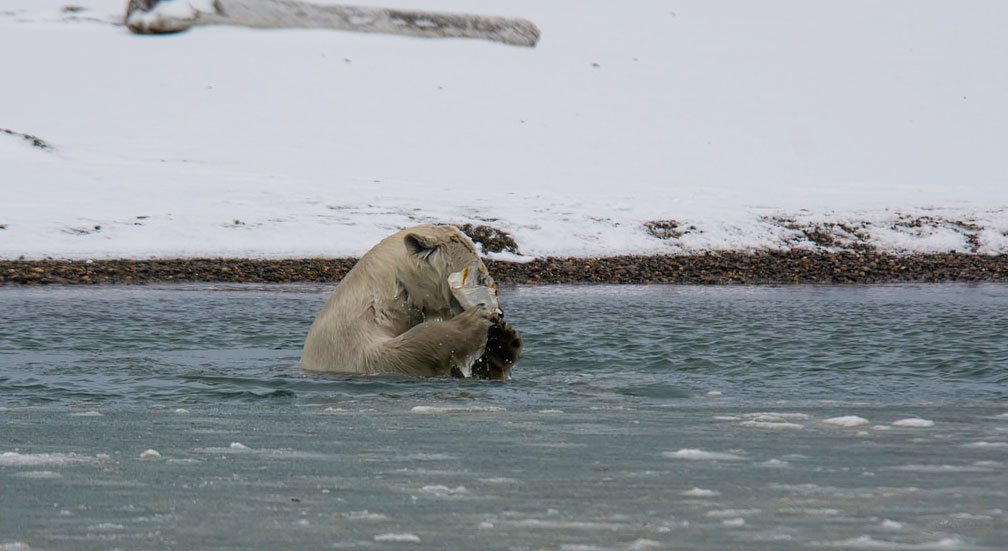
Polar bear chewing on a plastic bag, Kaktovik, AK on the Arctic Ocean. Photo source: ©© Anita Ritenour.
“The unprecedented plastic waste tide plaguing our oceans and shores, can become as limited as our chosen relationship with plastics, which involves a dramatic behavioral change on our part…”—© SAF — Coastal Care
Excerpts;
Here in the Arctic, hundreds of miles from the nearest big city, are some of the greatest loads of plastics on the planet. Studies find higher concentrations of microplastics in sea ice in these remote, high-latitude hotspots than in the five infamous ocean garbage patches. And a recent report finds airborne microplastics are falling on the far north mixed with snow…
Read Full Article; MSN, National Geographic (10-30-2019)
Record concentration of microplastic in Arctic sea ice; Science Daily (04-24-2018)
Experts have recently found higher amounts of microplastic in arctic sea ice than ever before. However, the majority of particles were microscopically small…
Plastic waste ‘building up’ in Arctic; BBC News (02-08-2018)
Plastic waste is building up in the supposedly pristine wilderness of the Norwegian Arctic, scientists say…
Once-pristine Arctic choking on our plastic addiction; CBS News (10-23-2017)
Earlier this year a global team of scientists sounded another alarm, revealing what they called the next major threat to the polar bears’ Arctic habitat: plastic…
The Arctic is a ‘dead end’ for ocean plastic; MNN (04-24-2017)
According to a new study, the Arctic serves as a “dead end” for hordes of marine debris drifting through the North Atlantic. Even though very little plastic waste is discarded within the Arctic itself, it’s still carried there — and then stranded — by ocean currents…
Industry is leaking huge amounts of microplastics, Swedish study shows; Science Daily (02-20-2018)
Plastic Litter Taints the Sea Surface, Even in the Arctic; Science Daily (10-22-2015)
For the first time, researchers show that marine litter can even be found at the sea surface of Arctic waters. Though it remains unclear how the litter made it so far north, it is likely to pose new problems for local marine life, the authors report…
Microplastic pollution in oceans is far worse than feared, say scientists; Guardian UK (03-12-2018)
The Ocean Is Contaminated by Trillions More Pieces of Plastic Than Thought, IOP Science (12-08-2015)
This new study suggests there are 15 to 51 trillion micro plastic particles (those less than 200 millimeters in size) in the world’s oceans, weighing between 93 and 236,000 metric tons. This is about seven times more than scientists had previously estimated…
More than 8. 3 billion tons of plastics made: Most has now been discarded; Science Daily (07-19-2017)
Humans have created 8.3 billion metric tons of plastics since large-scale production of the synthetic materials began in the early 1950s, and most of it now resides in landfills or the natural environment, according to a study.
High levels of microplastics found in Northwest Atlantic fish; Science Daily (02-16-2018)
A new study finds 73 percent of mesopelagic fish caught in the Northwest Atlantic had microplastics in their stomachs, one of the highest levels globally. These fish could spread microplastic pollution throughout the marine ecosystem, by carrying microplastics from the surface down to deeper waters. They are also prey for fish eaten by humans, meaning that microplastics could indirectly contaminate our food supply…
Whale and shark species at increasing risk from microplastic pollution – study; Guardian UK (02-05-2018)
Whales, some sharks and other marine species such as rays are increasingly at risk from microplastics in the oceans, a new study published in the journal Trends in Ecology and Evolution, suggests…
Plastic pollution: When The Mermaids Cry: The Great Plastic Tide, Coastal Care – ©2009
” Plastic is versatile, lightweight, flexible, moisture resistant, strong, and relatively inexpensive. Those are the attractive qualities that lead us, around the world, to such a voracious appetite and over-consumption of plastic goods. However, durable and very slow to degrade, plastic materials that are used in the production of so many products all, ultimately, become waste with staying power. Our tremendous attraction to plastic, coupled with an undeniable behavioral propensity of increasingly over-consuming, discarding, littering and thus polluting, has become a combination of lethal nature…
The unprecedented plastic waste tide plaguing our oceans and shores, can become as limited as our chosen relationship with plastics, which involves a dramatic behavioral change on our part…”









